Bullocks, Camels and Donkeys
• Until the railways came in the 1880s, everything was hauled on drays by bullocks, donkeys or camels.
• After that, the animals were still needed to get goods to and from the railway stations until motor transport took over.
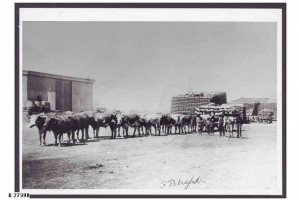
State Library of South Australia B27398 Bullock team at Hammond 1910, with stacks of bagged wheat.
• Camels took over some of the inland routes from the 1870s.
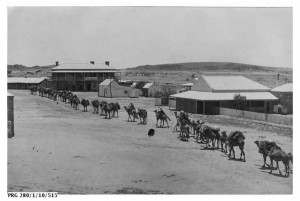
State Library of South Australia PRG/280/1/10/515 A long camel train with the animals carrying heavy loads arriving at Port Augusta, South Australia 1919
• Railways and road transport gradually replaced the teams. The last photographs of teams in the Flinders date from around 1950.
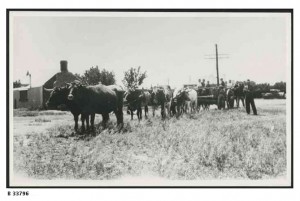
State Library of South Australia B33796. Bullock team at Hammond, 1950.

State Library of South Australia B34910. Donkey-drawn wagons being loaded at Copley Railway Station about 1920, with goods that have come in by train. It is difficult to see what is in the railway trucks behind the team, but it is probably cattle going south.

State Library of South Australia B24001
Camel train, with wool from Nappamerry Station in Queensland being unloaded at Farina Railway Station, 1928.
By Land and Sea
• Travel overland was difficult when goods were hauled by bullock drays along rough tracks. It was much easier to send things by sea.
• Pastoralists lobbied the colonial government to set up a port at the northern end of Spencer Gulf so wool could be sent out to market more easily and more profitably.
• In 1854 the government laid out the port town of Port Augusta. Wool and copper ore from mines in the Flinders were sent out to market from here, and supplies for the northern settlers were brought in.
• Port Augusta became the major regional port for exports from the north. Mining, transport and townships • Great Northern Mining Company owned the mines at Oratunga and Nuccaleena. It began to lobby the government in the 1860s for rail transport from mines in the north
to Port Augusta.
• The land up the western side of the ranges was too arid to attract private investors, and the colonial government didn’t have enough money to put in the railway line.
• They did fund a line of wells and surveyed a small township at each one to service the teamsters. Each township soon had an eating house. Hookina, Mern Merna, Edeowie, and Parachilna began life this way.
• Two more townships were surveyed at this time near the mines at Oratunga and Nuccaleena. This was the first copper route from the northern Flinders mines to Port Augusta.
• Once the Blinman mine began producing copper in 1862, traffic on the eastern side of the Ranges increased. The route ran through Willochra past the Kanyaka eating house. Eating houses opened at Wilpena and Arkaba East or west of the Ranges? • Graziers and miners in
the Flinders needed to get their goods to market. A railway line, they thought, would be cheaper and quicker than drays over rough tracks.
• The colonial government agreed, but it took 18 years to get the first stretch of line working.
• Should the line go east or west of the ranges? Altogether, six different routes were mapped before 1878 when work began.
• Most of the fertile land was to the east of the ranges, and that’s where most graziers and farmers settled.
• But although the land west of the ranges was more arid, the ground was generally flat. This made road and rail routes easier to build on the western side. Great Northern Railway
• When the first stage of the line from Port Augusta was finally built, it went through the Pichi Richi Pass to Quorn, then up the eastern side of the Ranges to Hawker. Here it crossed back to the western side.
• Goods from the eastern side of the ranges were brought across to the west through the few passes
– Pichi Richi and Horrocks initially, then the more northerly passes.
• The Great Northern Railway reached Quorn in 1879, Hawker in 1880, Beltana in 1881, Farina in 1882, Herrgott Springs (Marree) in 1884 and Oodnadatta in 1891. The line reached Alice Springs in 1929.
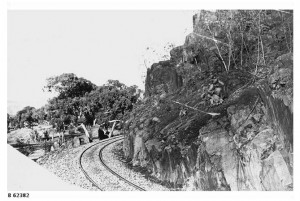
State Library of South Australia B62382. Railway track laid around a bend at the Pichi Richi Pass on the Great Northern Railway 1885.
Railway expansion
– During the 1880s the railway networks expanded steadily north and east. Which way would the tracks go? Towns would live or die depending on their connection to the railway.
– On the western site of the range, the old dray route was much closer to the ranges than the new railway line about 8km to the west.
- Most of the little towns created for the teamsters declined rapidly. o Drovers kept the old Edeowie pub going till 1886,
- Farmers kept the Hookina pub going until 1897 when another great drought forced even the pub to close.
– Most dray traffic north went through Melrose, which became isolated by the new railway line to Quorn.
– Kanyaka faded away after a new railway station was built at Wilson, 10 km away (1881).
– When silver was found near what is now Broken Hill, traffic from South Australia travelled there first from Burra. As traffic grew, the government surveyed more railway lines.
– Peterborough owes its existence to railways. This site was chosen for the junction between the lines that eventually ran from Port Pirie to Broken Hill, and from Adelaide through Burra to Quorn and the far north.
Tricky connections : gauges
Looking at the map of railway lines, you might think that travelling east-west or north-south would be easy. But the lines on this map are of four different widths (gauges). – The Great Northern Railway was first built in narrow gauge – it was cheaper to build and had lower operating costs than the wider gauges. – A broad gauge (five feet three inches) line from Adelaide through Gawler Riverton and Burra to Terowie was finished in 1880. – A narrow gauge connection from Terowie, through Peterborough, was made to Port Pirie in 1881 – The narrow gauge was extended from Peterborough through Orroroo and Carrieton to Quorn in 1882. Here it connected with the Great Northern Line that ran up through Hawker. This line no longer runs. – National north-south and east-west links were progressively built in the twentieth century in a third gauge- standard gauge (four feet eight and a half inches).
| Wherever the gauge changed, passengers had to change trains – Explore the Flinders Ranges explains : ‘With the opening of the standard gauge (4’8½”) transcontinental railway to Western Australia in 1917, passengers travelling west transferred from broad to narrow gauge at Terowie, and from narrow to standard gauge at Port Augusta’. Quorn became a national cross roads because of its position on the connecting lines. ‘The completion of the standard gauge link between Port Pirie and Port Augusta in 1937 ended Quorn’s east-west-link. Nevertheless, its peak years were during the 1940s (with troop trains during the World War II) and the 1950s (with up to 20 coal trains per day and the ‘Ghan’ to Alice Springs’ (Barker et al p. 123). |
South Australian railways were, in fact, an inefficient mix of narrow, standard and broad gauges. Inland connections • In the 1890s, George Noble of Balcanoona station opened up a route through the Italowie Gorge to Leigh Creek railway station. • Wool from Wooltana and other runs east of the range could then be railed out from there, saving the longer haul to the south.
State Library of South Australia B40004 Bullock team carrying wool to port. Port Augusta about 1889. • After the wheat drive had run out, pastoral expansion continued. Goods travelled further inland. • Farina and Marree were bases for camel trains carrying supplies via Innamincka and Birdsville to South West Queensland’s channel country.
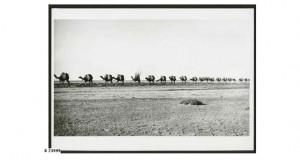
State Library of South Australia B23999. Camel train bringing wool into Farina, 1928
Effects of 1950s changes
• To carry coal from Leigh Creek, the old railway line to Port Augusta was upgraded.
• At the same time, the route was changed to come all the way up the western side of the Flinders, rather than coming up the east.
• The main line north is part of the national rail network.
• Since 1956 it has run along the western side of the Flinders Ranges, connecting Adelaide to Central Australia and Darwin. The Ghan passenger train runs on this line.
• Both Hawker and Quorn protested, but they both survived the change.
• Beltana was not so lucky: the new line to Leigh Creek swung north-west beyond Parachilna to avoid the hills around Beltana. After this, Beltana’s population drifted away.
• Beltana railway station dates from 1880.
| Beltana Station Beltana was a “changeover station” with one crew working the Beltana to Quorn section and the other from Beltana to Marree. A standby locomotive was also stationed at Beltana and the freight platform was equipped with a crane and turntable. The town flourished during the construction of the line, and the population was permanently boosted by a Station Master and his family and pumpers, porters and fettlers. Sadly, travel on the train was too expensive for the ordinary settler, so the service was almost exclusively used by station people, drovers and miners to move stock and ore. In 1926 the railway freight shed was turned into a giant restaurant when nearly 5,000 people came in a special train from Pt Augusta to attend the Great Northern Athletics Association Exhibition and Sports Day. When the demand for coal from Leigh Creek increased in the early 1950s, the old line was found to be too steep in places for the heavy coal trains and a new standard gauge line was re-routed 11km to the west of the town to enable it to cross flatter country. In 1956 the Beltana railway station, its freight shed, line, crews and railway paraphernalia became redundant. … In the 1950s and 60s Beltana lost its railway, its hospital, its Police Officer, school and businesses. It no longer had a reason to exist.Extract from Beltana Website: http://www.beltana.org.au/index.php/history |
Railway workers
• Like miners, many railway workers were single men willing to travel far and work hard for a living.
• A gang of eighty Chinese was brought in 1878 to work on the Northern Railway. Although there was a lot of resistance to them, they were good workers.
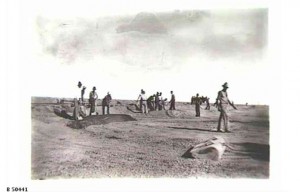
State Library of South Australia B50441. Railway Fettlers scooping foundation for deviation across Strangways Creek at 545 miles on the Great Northern Line 1938.
It looks as though the work was being done by hand – no machinery in sight!
- Accommodation for railway workers was very basic while the lines were being built.
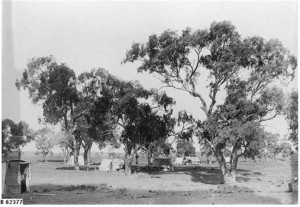
State Library of South Australia B62377. Workers camp near Beltana 1885.
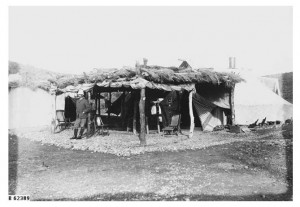
State Library of South Australia B62389 A railway engineer stands outside his camp accommodation during construction of the Great Northern Railway at Beltana, about 1885.
• Later on, when lines were established and had to be maintained, simple cottages were built at regular intervals for the railway workers (fettlers).
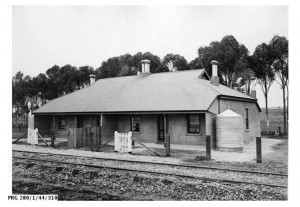
State Library of South Australia PRG 280/1/44/310 Two typical railway fettlers’ cottages built alongside the rail tracks.
Bringing in Food and supplies
– Goods were carried in by bullock drays and camels
– Hawkers with vans full of goods travelled a long, slow round between stations. They could carry some dried foods, cloth and household supplies.
– As the farming towns arose, hawkers would base themselves in a town and make much shorter rounds between farms. Their shorter rounds meant they could now carry some fruit and vegetables. Some mainly provided a delivery service for a store in the town.
– Many hawkers switched to trucks when they became available.
– Trains carried groceries for local stores, baskets of vegetables or fruit, live fowls in crates and pats of butter wrapped in wet calico as well as general supplies.
– Storekeepers now rely on road delivery – or drive down once a week to the produce markets in Adelaide to hand pick their stock.
– Meat was killed locally – on farms and stations, or by a butcher in town. Local meat is available from some butchers – and some still make their own sausages.
Resources
Wikipedia http://en.wikipedia.org/wiki/Rail_transport_in_South_Australia#Broad_gauge_lines
